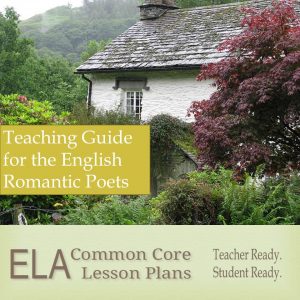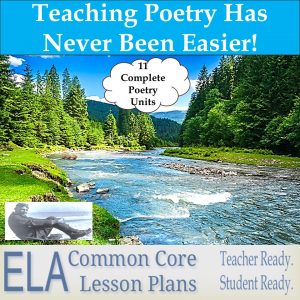Try an analysis of poems by John Keats to impress your coworkers and classmates at your next Friday night poetry party. Or I guess you could use it to make everyone in your English literature class think you’re romantic and intelligent.
If you would like step-by-step instructions on how to do a poetry analysis, follow the link.
A Bright Star

Yes, you can spend multiple class periods on poetry without the dreaded 2-minute reading followed by 49 minutes of stammering. The British Romanticism Teaching Guide includes an overview of British Romanticism and an analysis of selected poems by William Blake, William Wordsworth. Samuel Taylor Coleridge, Lord Byron, Percy Shelley and John Keats.
Ye unblessed being
Born in despair
Afore blooming fully
Was eclipsed by death cruellyThough had a little past in poesy Art
Yet Great and Grand, ceased to be lost
Ah! Grief came to you as luxury
Indeed beauty dwells with melancholyYou’re wrong when you stated
‘My name was write in water’
Behold! Like a Polar Star at night
Make sensations dark illuminatedA Dime-god of a sensuous claim
Bereaved, bereft and lost
Words those you sweetly glossed
Mistook by and harshly exclaim
Your sweetly tuned phrases
Are symbol of high Romance
That brings every soul in trance
And halt a thousand gazes
An ardent lover and a true Romantic
Like a Sappho you’re marked as sensuous
But thy lyrics sweets are more precious
Enough to make tender hearts frantic
Analysis of “A Bright Star” by John Keats

Imagine having 11 complete poetry units with handouts and lesson plans completed. You don’t need to imagine. These units are teacher ready and student ready. Just print, make copies, and accept accolades from colleagues and students.
Hopefully, you’ve checked out the step-by-step instructions for writing a poetry analysis.
Observations and Analysis of “Bright Star” by John Keats:
- The poem is an English/Shakespearean Sonnet, a 14 line poem with an ababcdcdefefgg rhyme scheme written in iambic pentameter. The basic premise of a Shakespearean sonnet is as follows: (1) In lines 1-12 a problem is presented; (2) Lines 13-14 contain a couplet that solves the problem or answers the question posed. In “Bright Star” the problem is the poet wishes to be as steadfast as a bright star, yet does not wish to be alone in the night looking down on the beautiful Earth. He would rather be “Pillow’d upon my fair love’s ripening breast” (10). The poet explains in the couplet that if forced to choose, he would choose the breast and die as opposed to being steadfast and immortal.
- Lines 1-4: Although the speaker in the poem wishes to be steadfast, he does not wish to be alone. He compares the bright star’s situation with that of an Eremite. For those of you who don’t know, an eremite is a religious hermit, one who lives a life of seclusion. It’s probably not a coincidence that Keats uses a metaphor reminiscent of celibacy to compare the bright star to, especially in the context of wanting to rest on a “ripening brest” (10).
- Lines 5-8: Keats describes all that the bright star sees: “pure ablution,” “the new soft-fallen mask / Of snow upon the mountains and moors,” yet would give all these views up to lay upon his “fair love’s ripening breast” (10). This man loves breasts. Once again, newly fallen snow and pure ablution represents purity and contains a connotation of sexual purity, especially when put in context. In other words, take your innocence and purity, just give me my “ripening breast” (10).
- Lines 9-12: “No,” says the poet. Take your purity, but I’d still like to keep the steadfastness, the immortality.
- Lines 13-14: The poet realizes he cannot have it both ways. Humans cannot be steadfast and immortal and love is an essential part of being human. When given the choice, Keats chooses to be human. Of course, what’s he going to say, he really has no choice. He is human. He really is going to die. If life gives you lemons (or “love’s ripening breast” (10).), you might as well squeeze them.
To Solitude
Let it not be among the jumbled heap
Of murky buildings; climb with me the steep, —
Nature’s observatory — whence the dell,
Its flowery slopes, its river’s crystal swell,
May seem a span; let me thy vigils keep
‘Mongst boughs pavilion’d, where the deer’s swift leap
Startles the wild bee from the foxglove bell.
But though I’ll gladly trace these scenes with thee,
Yet the sweet converse of an innocent mind,
Whose words are images of thoughts refin’d,
Is my soul’s pleasure; and it sure must be
Almost the highest bliss of human-kind,
When to thy haunts two kindred spirits flee.
Analysis of “To Solitude”
Observations and Analysis of Poems by John Keats: “To Solitude”
- Rhyme Scheme: abbaabbacddcdc
- Meter: iambic pentameter
- Form: “To Solitude” is a sonnet, resembling, but not identical to an Italian/Petrarchan sonnet. Unlike a Shakespearean sonnet that wraps things up nicely with an ending couplet, “To Solitude,” as with Italian sonnets, presents the issue in the first eight lines, and the solution in the final six lines. The turning point in a sonnet is called the volta, which literally means turn.
- In the first eight lines, the poet expresses his desire that if he must be alone, he would prefer to be alone in nature as opposed to the city. In the last six lines, he progresses even further, exclaiming to solitude that although he would “gladly trace these scenes with thee” (9), he would rather have the companionship of a “kindred spirit” (14).
- The poem begins with an apostrophe to solitude in line 1. Keats tells solitude that if he must be alone, he’d rather it not be “among the jumbled heep / Of murky buildings” (2-3).
- The middle of line 3 jolts us with a semi-colon and an abrupt change of thought. He asks solitude, “climb with me the steep” (3), followed by a jolting dash, followed by “Nature’s observatory” and another dash in line 4. Keats breaks the poem’s rhythm, drawing emphasis to the contrast between the dirtiness of city life and the purity of nature, a common theme with British Romantic poets.
- Lines 5-8 contain nature imagery, emphasizing its beauty: “flowery slopes, its river’s crystal swell” (5), “boughs pavillion’d, where the deer’s swift leap / Startles the wild bee from the foxglove bell” (7-8)
- The volta occurs with the first word in line 9: “But.” Any salesperson will tell you the power of “but”. Any time a customer raises an objection, especially one which is true, all the salesperson must do is agree with the objection, say “but,” and counter the objection. All the customer pays attention to at that point is everything after the “but.” In this case, the poet wishes solitude to forget all that stuff about how great solitude is in nature and grant him his request for companionship.
- The final five lines pleads the poet’s case to be with someone. He states, “Almost the highest bliss of human-kind, / When to thy haunts two kindred spirits flee” (13-14). Keats still lauds solitude in Nature, but adds a caveat that two “kindred spirits” alone in nature is best.
I’m not one to brag, but I did one fantastic job of analyzing this poem by John Keats. There’s plenty of information for you to write your own analysis. Feel free to thank me by sharing this with your poetry buddies.
